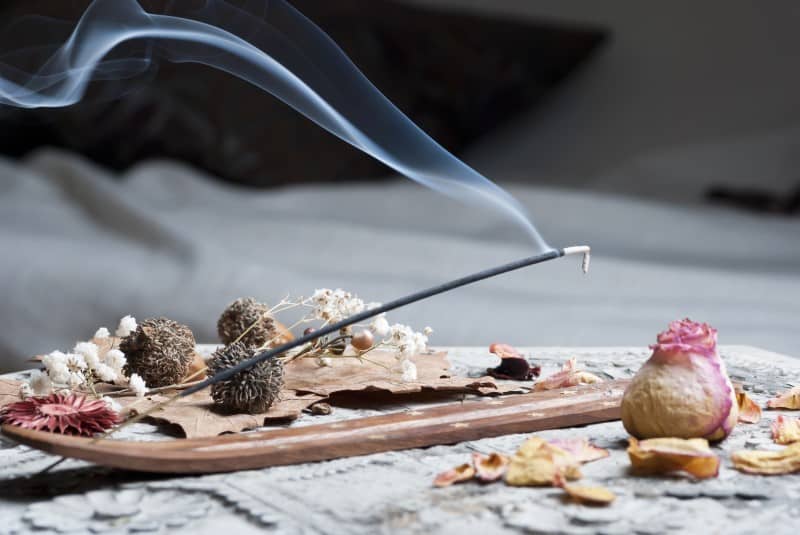If you enjoy burning incense you have probably noticed how much smoke it produces as it smolders. Now, some people are not bothered at all by it, but others might find it difficult to breathe in all of that smoke. Even if you enjoy the fragrance, you may look around a smoke-filled room and wonder, is incense natural?
Historically, most of the materials used to make incense have been natural. Plants, aromatic wood, and resins are the base ingredients even today, but these base ingredients, plus fragrance, and binding compounds can all vary by company and even within one company. So I’ve learned that incense is sometimes natural but it varies widely by company.
If you want to continue to burn incense but want to make sure that it isn’t causing you to become ill in the process, read on to understand how incense is made, how to tell if it’s natural, and what you can do to protect yourself from potential harm.

What Is Incense Really Made Of?
Incense has been used for centuries in different ways but most commonly by multiple cultures and religious groups. But it is also used for aesthetic reasons, solely for filling a space with fragrance, to engage in rituals, or as aromatherapy.
Frankincense and myrrh resins combined with aromatic flowers, seeds, wood and roots were historically used to create the earliest forms of incense.
This ingredients list evolved to include resins like storax, galbanum, and more only to devolve into the incorporation of synthetic materials. Once perfumes and resin substitutes were added to the mix, incense became less known for its natural properties.
But there are many different kinds of incense and ingredients used in this industry, which is unregulated. Overall incense is a paste that usually made from a combination of plant and scent materials, plus a binder, all of which is then shaped into a cone or compacted around wood to create incense sticks. There is some variance to the process, but this is the most common approach.
Scent materials vary as well, they can either be manufactured fragrance oils (chemicals) or essential oils.
So, Is Incense Natural?
Frankly, it is difficult to determine this not only because incense is not connected to any regulating agency, but also because the term “natural” doesn’t have a concrete definition.
Incense is kind of an odd commodity that doesn’t squarely fit into the cosmetics or food industries. Because it’s somewhere in between, it can help us to understand how each industry defines, “natural.”
In the cosmetics industry, natural products are not clearly defined. The same is true for the category, “organic,” – no one really knows what ingredients go into these products.
The general definition for the term, natural, is, “existing in or caused by nature; not made or caused by humankind.”
The Food and Drug Administration (FDA) uses the term, natural, “to mean that nothing artificial or synthetic (including all color additives regardless of source) has been included in, or has been added to, a food that would not normally be expected to be in that food.” Health benefits are not a consideration of the FDA when using this term.
Most incense imports come from China, Thailand, or India and there are no regulating agencies that set product standards for incense manufacturers from overseas or in the United States.
For instance, I am looking at a box of incense that I have that was hand-rolled and imported from India. There isn’t an ingredients list, but there are a few caution images that indicate that you should not directly inhale the incense and that it should be burned near a window or in a room with circulation.
Their website notes that their incense is, “Suitable for daily use as it does not emit any harmful toxic gases.”
Based on their company video, it appears that they use both natural and synthetic fragrances in their products.
And to their credit, they do not seem to claim to create natural incense. Instead they state that they are, “known globally for manufacturing and exporting perfumed agarbatti.” Agarbatti is Sanskrit for incense.
Then you have a company like Chakra & Luck, which states that their incense is 100% natural, and, “(f)ree of harsh chemicals and artificial fragrances,…”
Based on the general definition of natural, the only incense that would fit into this definition is the kind that is made without any synthetic ingredients. The dilemma, though, is that many companies do not list their ingredients and some claim to be all-natural while selling incense made with synthetic materials.
The only way to know for sure is to seek out companies that list and only use essential oils and other nature-made properties.
Is Incense Safe to Use?
When you think of the word, natural, the mind automatically associates it with health and safety. So it is hard not to wonder whether there are any health concerns related to the use of incense.
There is a study that suggests that inhaling incense smoke is equally dangerous as inhaling cigarette smoke.
But studies on this topic tend to have study participants who are exposed to incense smoke for extended periods of time across decades. Such effects may not be generalizable to populations who have had occasional exposure to incense smoke over a shorter period of time.
The Environmental Protection Agency (EPA) conducted a literature review and market analysis to consider whether candles and incense might contribute to indoor air pollution. The EPA’s concern with incense is that when burned, it can release particulate matter (PM). They define PM as “a complex mixture of extremely small particles and liquid droplets.”
Another way to describe it is as atmospheric aerosol particles. They become suspended in the air and are microscopic in size, so they can’t be seen by the naked eye.
This form of pollution can be made up of metals, organic chemicals, soil and dust particles, and even acids like nitrates and sulfates. So it’s understandable that the concern is that when PM is inhaled, it passes through the nose, throat, and then into the lungs, potentially causing harm there or in the heart.
Although some of the studies they reviewed indicated that there might be a link between exposure to incense smoke and health conditions, such as, asthma, cancer, and contact dermatitis, there was no definitive information given.
It is possible that carbon monoxide and benzene are released from burning incense in potentially harmful amounts, but again, there was not any definitive information about that either. There is no indication of how many hours a person would need to be exposed to this smoke over a given period of time in order for it to have harmful effects.
Overall, no scientific study has been able to prove direct causation between inhaling incense smoke and the development of any specific illness, like heart disease, lung cancer, or even asthma. It is true that incense smoke can agitate a pre-existing asthma condition, but it has not been proven to directly cause asthma.
So although incense might possibly be unsafe to inhale over an extended period of time, there is no concrete evidence to help gauge for how long and under what conditions.
Is There Any Truly Natural Incense on the Market?
There are some companies that indicate that they only use essential oils and natural ingredients to create their incense. Here are a few that I’ve found:
Chakra & Luck Natural Incense Sticks
- Uses essential oils, herbs, bamboo sticks, and wood gums
- All organic and eco-friendly ingredients
- Non-toxic
- No artificial fragrances
- Blended and rolled by hand
Brahma’s Natural Incense Sticks
- No chemicals, artificial scents or colors
- Qualified vegan
- Non-toxic, organic
- Uses pure essential oils, natural resins, herbs and wood
- No charcoal or sooty smoke
Shoyeido Incense Sticks
- Pure incense, no wooden stick
- Japanese bay tree and water used as binding agent
- Raw ingredients
- No synthetic oils or fragrances
Should I Use Natural Incense?
If you are deeply concerned about the possibility of using synthetic incense that claims to be natural, you may want to consider buying from brands that vow to only use natural ingredients: plants, herbs, wood, and essential oils.
Incense that has a strong perfume-like smell was likely created with synthetic chemical fragrances.
If your concern is about inhaling toxins from incense you have that might not be natural, one thing that you can do is take steps to reduce your exposure to incense smoke, since the science is vague about the effects of that exposure.
Making sure your environment is well-ventilated is one way to reduce any potentially harmful effects of inhaling incense smoke. Opening windows or screened doors can help protect you and also better circulate the fragrance throughout your environment.
You should also allow the incense to burn a good distance away from you so that you are not directly inhaling any fumes.
Another option is to consider alternatives to incense. Adding essential oils to a diffuser or burning natural candles might be better for you.
Read more:
